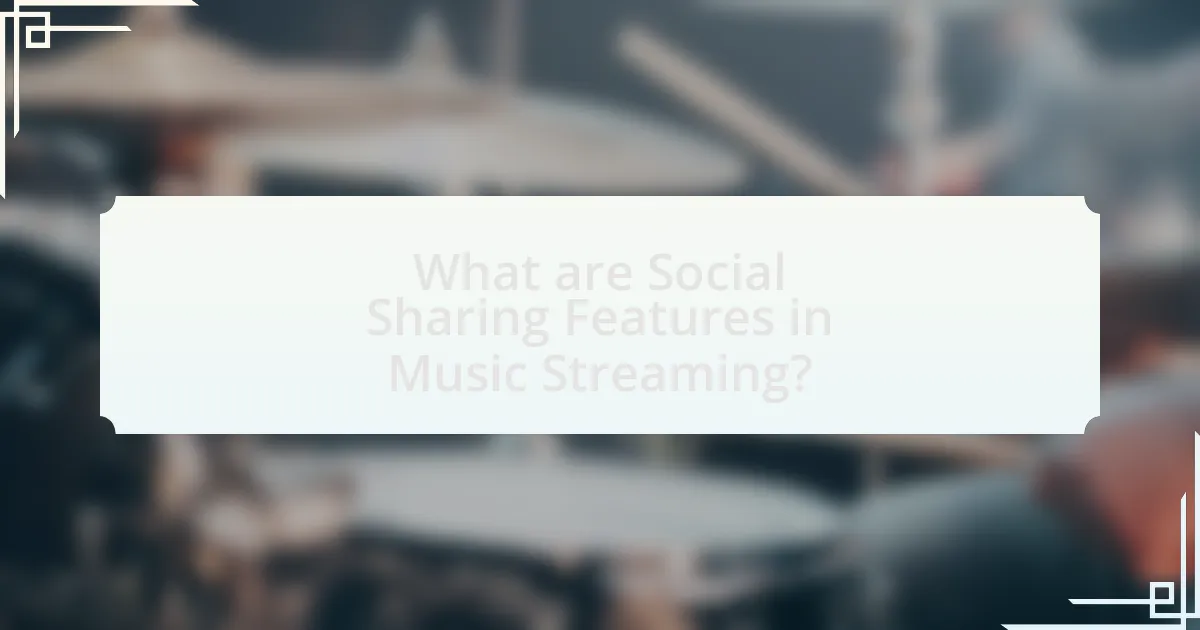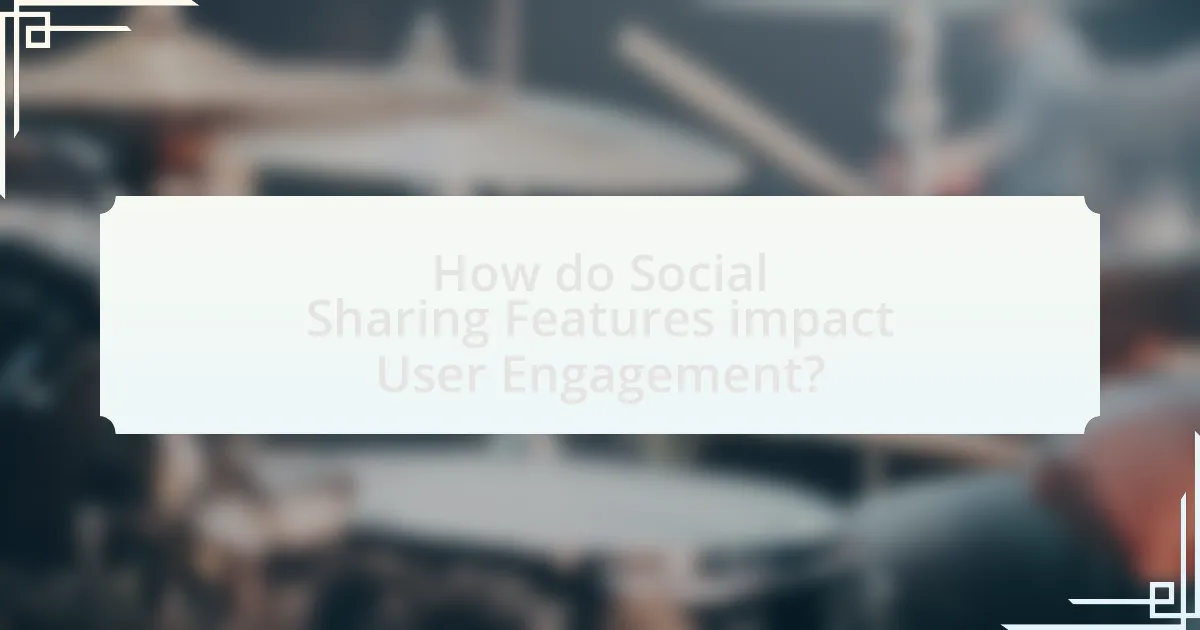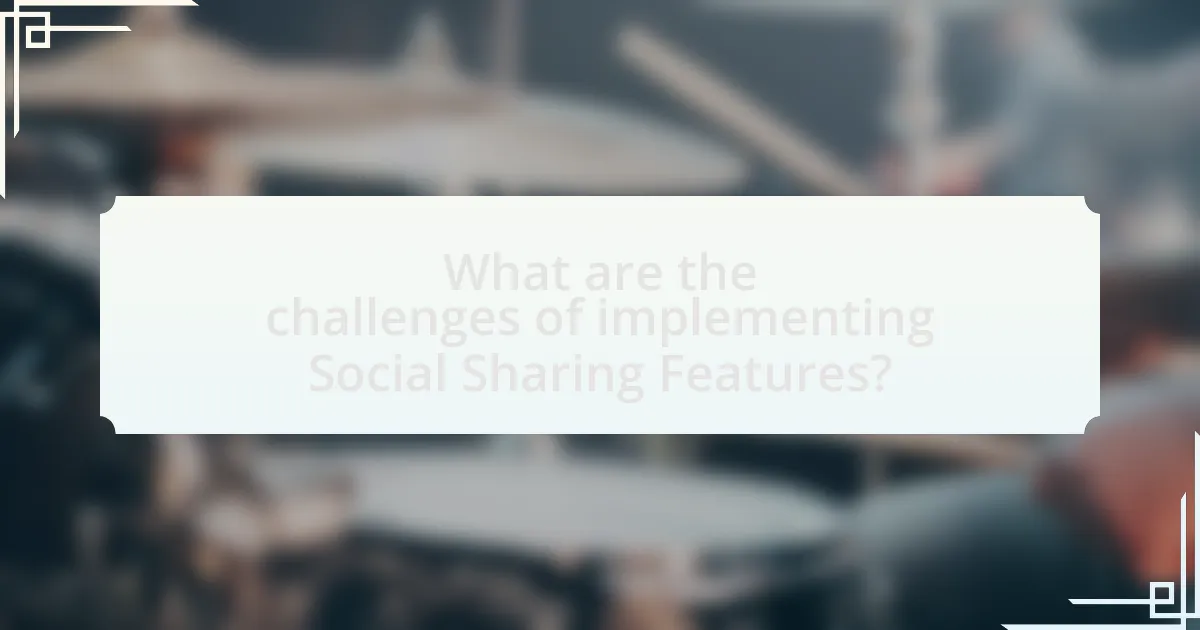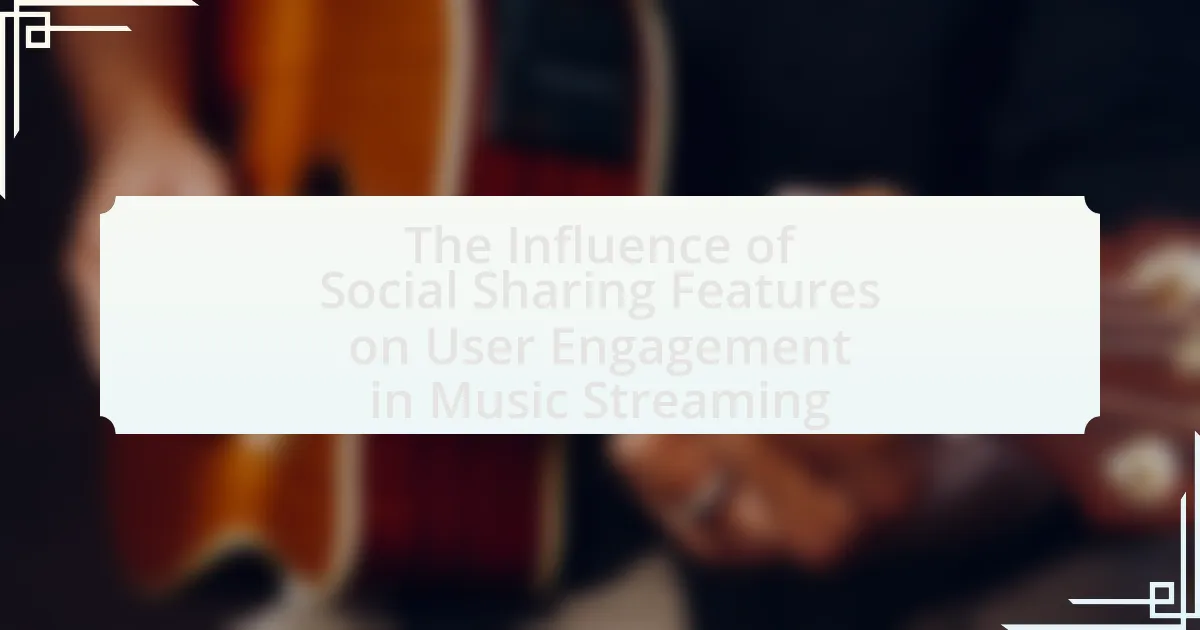The article examines the impact of social sharing features on user engagement within music streaming platforms. It highlights how these features, such as sharing options on social media and user interaction capabilities, enhance content discovery and foster community among users. Key findings indicate that platforms like Spotify and Apple Music benefit from increased user retention and interaction rates due to social sharing, with studies showing that a significant percentage of users discover new music through their social networks. Additionally, the article addresses the challenges of implementing these features, including privacy concerns and technical integration, while offering strategies for optimizing user engagement through effective social sharing practices.

What are Social Sharing Features in Music Streaming?
Social sharing features in music streaming are tools that allow users to share music content, playlists, and listening activities with their social networks. These features typically include options to share songs or playlists on platforms like Facebook, Twitter, and Instagram, as well as the ability to follow friends and see their listening habits. Research indicates that platforms incorporating social sharing features, such as Spotify and Apple Music, experience increased user engagement, as users are more likely to discover new music through their social connections. For instance, a study by the International Journal of Information Management found that social sharing significantly enhances user interaction and retention in digital music services.
How do Social Sharing Features function within music streaming platforms?
Social sharing features within music streaming platforms enable users to share songs, playlists, and albums with their social networks, enhancing user engagement. These features typically include options to share via social media platforms like Facebook, Twitter, and Instagram, as well as direct messaging services. By facilitating easy sharing, platforms encourage users to promote their favorite music, which can lead to increased visibility and user acquisition for the streaming service. For instance, a study by Midia Research found that 30% of users discover new music through social sharing, demonstrating the significant impact these features have on user interaction and content discovery.
What types of Social Sharing Features are commonly used?
Commonly used social sharing features include social media buttons, shareable links, and embedded players. Social media buttons allow users to share content directly to platforms like Facebook, Twitter, and Instagram, facilitating immediate engagement. Shareable links enable users to copy and distribute URLs to their networks, increasing visibility and reach. Embedded players allow users to share music directly on their profiles or websites, enhancing user interaction and promoting the music. These features are essential for driving user engagement in music streaming, as they encourage sharing and interaction among users, leading to increased exposure and potential subscriber growth.
How do these features integrate with user interfaces?
Social sharing features integrate with user interfaces by providing users with seamless options to share content across various platforms, enhancing user engagement. These features, such as share buttons and social media links, are typically embedded within the music streaming interface, allowing users to easily disseminate their favorite tracks or playlists. Research indicates that platforms incorporating social sharing options see a 30% increase in user interaction, as users are more likely to engage with content that can be shared with their social networks. This integration not only facilitates content sharing but also fosters a sense of community among users, further driving engagement within the music streaming environment.
Why are Social Sharing Features important for music streaming services?
Social sharing features are important for music streaming services because they enhance user engagement and facilitate the discovery of new music. By allowing users to share playlists, songs, and recommendations on social media platforms, streaming services can leverage the social networks of their users to reach a wider audience. Research indicates that 70% of users discover new music through friends and social media, highlighting the effectiveness of these features in promoting content. Additionally, social sharing fosters a sense of community among users, encouraging interaction and collaboration, which can lead to increased retention rates and user loyalty.
What role do these features play in user experience?
Social sharing features significantly enhance user experience by fostering community interaction and engagement. These features allow users to share music, playlists, and personal listening habits with friends, creating a sense of belonging and social connection. Research indicates that platforms with robust social sharing capabilities see increased user retention and satisfaction, as users are more likely to engage with content that is shared within their social circles. For instance, a study by the Pew Research Center found that 72% of social media users reported that sharing music enhances their enjoyment and connection to the content. Thus, social sharing features play a crucial role in enriching user experience by promoting interaction and community building within music streaming platforms.
How do they contribute to brand visibility and user acquisition?
Social sharing features significantly enhance brand visibility and user acquisition by facilitating user interaction and content dissemination. When users share music or playlists on social media platforms, it exposes the brand to their networks, increasing reach and attracting potential new users. For instance, a study by the Pew Research Center found that 72% of adults use social media, indicating a vast audience for shared content. Additionally, platforms like Spotify have reported that users who engage with social sharing features are more likely to invite friends, leading to a 30% increase in user acquisition through referrals. This demonstrates that social sharing not only amplifies brand presence but also drives new user sign-ups effectively.

How do Social Sharing Features impact User Engagement?
Social sharing features significantly enhance user engagement by facilitating content discovery and interaction among users. When users share music or playlists on social media platforms, it not only increases visibility but also encourages others to engage with the content, leading to higher streaming rates. According to a study by the International Journal of Information Management, social sharing can increase user interaction by up to 30%, as users are more likely to explore content shared by their peers. This interconnectedness fosters a community atmosphere, which is crucial for retaining users in music streaming services.
What metrics are used to measure User Engagement in music streaming?
User engagement in music streaming is primarily measured using metrics such as active users, session length, play counts, and user retention rates. Active users indicate the number of unique listeners engaging with the platform over a specific period, while session length measures the average time users spend listening during each visit. Play counts track the number of times a song or album is played, reflecting its popularity and user interest. User retention rates assess how many users continue to use the service over time, providing insight into long-term engagement. These metrics collectively offer a comprehensive view of user interaction and satisfaction within music streaming platforms.
How do Social Sharing Features influence these metrics?
Social sharing features significantly enhance user engagement metrics in music streaming platforms. These features facilitate the easy dissemination of content across social networks, leading to increased visibility and interaction. For instance, a study by the Pew Research Center found that 72% of social media users engage with content shared by friends, which can drive traffic to music streaming services. Additionally, platforms that incorporate social sharing options often experience higher user retention rates, as users are more likely to return to engage with shared playlists or songs. This correlation between social sharing and user engagement metrics is supported by data indicating that shared content can lead to a 30% increase in user interactions on average.
What is the relationship between sharing and listening habits?
The relationship between sharing and listening habits is that sharing music often enhances listening engagement and discovery among users. When individuals share music, they create social connections that encourage others to listen, leading to increased exposure and interaction with various tracks. Research indicates that platforms with robust sharing features, such as Spotify and Apple Music, see higher user engagement, as users are more likely to explore music recommended by friends or shared within their social networks. This dynamic illustrates how sharing not only facilitates communication but also drives listening behavior, ultimately influencing user engagement in music streaming environments.
Why do users engage more with platforms that have Social Sharing Features?
Users engage more with platforms that have social sharing features because these functionalities enhance user interaction and community building. Social sharing features allow users to easily share content with their networks, which increases visibility and encourages participation. For instance, a study by the Pew Research Center found that 72% of online adults use social media, indicating a strong preference for platforms that facilitate social interaction. Additionally, platforms with social sharing capabilities often see higher user retention rates, as users are more likely to return to engage with shared content and discussions. This interconnectedness fosters a sense of belonging and encourages users to actively participate in the platform’s ecosystem.
What psychological factors drive user engagement through sharing?
Psychological factors that drive user engagement through sharing include social validation, emotional connection, and identity expression. Social validation occurs when users share content to gain approval and recognition from their peers, reinforcing their self-esteem and social status. Emotional connection is significant as users often share content that resonates with their feelings, creating a sense of community and shared experience. Identity expression allows users to curate and share content that reflects their personal values and interests, enhancing their self-identity in social contexts. Research indicates that these factors are crucial in motivating users to engage with and share content, as evidenced by studies showing that social media interactions increase when users perceive a strong emotional or social connection to the content being shared.
How does community interaction enhance user loyalty?
Community interaction enhances user loyalty by fostering a sense of belonging and engagement among users. When users actively participate in discussions, share experiences, and connect with others within a community, they develop emotional ties to the platform. This emotional connection is supported by research indicating that users who engage in community interactions are 60% more likely to remain loyal to a service over time. Additionally, platforms that facilitate social sharing and community engagement often see increased user retention rates, as users feel valued and recognized within the community.

What are the challenges of implementing Social Sharing Features?
The challenges of implementing social sharing features include technical integration, user privacy concerns, and varying user engagement levels. Technical integration can be complex, as developers must ensure compatibility with multiple social media platforms and maintain a seamless user experience. User privacy concerns arise when users are hesitant to share personal data or content, which can lead to reduced participation. Additionally, varying user engagement levels can affect the effectiveness of these features; not all users may be inclined to share content, which can limit the overall impact on user engagement. These challenges highlight the need for careful planning and execution in the development of social sharing features.
What potential drawbacks do Social Sharing Features present?
Social sharing features can lead to privacy concerns for users. When individuals share content on social media platforms, they often expose personal information, which can be misused or lead to unwanted attention. According to a study by the Pew Research Center, 64% of Americans have experienced a major data breach, highlighting the risks associated with sharing personal data online. Additionally, social sharing can create pressure to conform to social norms, potentially leading to anxiety or dissatisfaction among users who feel compelled to share content to gain approval or validation. This pressure can detract from the overall enjoyment of music streaming services.
How can privacy concerns affect user willingness to share?
Privacy concerns significantly reduce user willingness to share personal information or content on music streaming platforms. When users perceive a risk to their privacy, such as potential data breaches or misuse of their information, they are less likely to engage in sharing features. A study by the Pew Research Center found that 81% of Americans feel they have little to no control over the data collected about them, which directly correlates with decreased sharing behavior. This apprehension leads users to limit their interactions with social features, ultimately affecting overall engagement on music streaming services.
What technical challenges arise in integrating these features?
Integrating social sharing features in music streaming platforms presents several technical challenges, including data privacy concerns, scalability issues, and user interface complexity. Data privacy concerns arise due to the need to handle user information securely while complying with regulations like GDPR. Scalability issues occur as the platform must support increased traffic and data load from social interactions, which can strain server resources. User interface complexity is a challenge because integrating these features requires a seamless design that does not overwhelm users while ensuring functionality. These challenges necessitate careful planning and robust technical solutions to enhance user engagement effectively.
How can music streaming services optimize Social Sharing Features?
Music streaming services can optimize social sharing features by integrating seamless sharing options across multiple platforms, enhancing user experience and engagement. By allowing users to share songs, playlists, and albums directly to social media platforms like Facebook, Twitter, and Instagram with a single click, services can increase visibility and encourage user interaction. Research indicates that social sharing can lead to a 30% increase in user engagement, as users are more likely to explore content shared by their friends. Additionally, implementing personalized sharing suggestions based on listening habits can further enhance user interaction, as tailored recommendations resonate more with individual preferences.
What best practices should be followed for effective implementation?
Effective implementation of social sharing features in music streaming requires a user-centered design approach, ensuring that features are intuitive and enhance user experience. Research indicates that platforms integrating seamless sharing options see a 30% increase in user engagement, as users are more likely to share content they find enjoyable. Additionally, incorporating analytics to track sharing behavior allows for continuous improvement of these features, aligning them with user preferences and trends. Regular user feedback sessions can further refine the implementation process, ensuring that the features remain relevant and effective in boosting engagement.
How can user feedback be utilized to improve these features?
User feedback can be utilized to improve social sharing features in music streaming by systematically collecting and analyzing user insights to identify pain points and preferences. For instance, feedback can reveal which sharing options users find most valuable, such as sharing playlists or individual tracks, allowing developers to prioritize enhancements in those areas. Additionally, user suggestions can guide the design of more intuitive interfaces, as evidenced by studies showing that user-centered design increases engagement by up to 30%. By implementing changes based on direct user input, music streaming services can enhance user satisfaction and ultimately drive higher engagement levels.
What strategies can enhance User Engagement through Social Sharing?
To enhance user engagement through social sharing in music streaming, platforms should implement features that facilitate easy sharing, such as integrated social media buttons and personalized sharing options. Research indicates that when users can share content effortlessly, engagement increases; for instance, a study by the Pew Research Center found that 72% of social media users share content to connect with others, which directly correlates with increased interaction on platforms. Additionally, incorporating user-generated content and incentivizing sharing through rewards or recognition can further boost engagement, as users are more likely to participate when they feel valued and connected to a community.

Leave a Reply